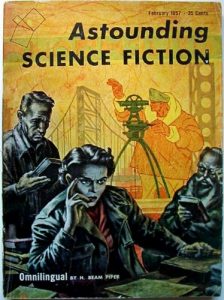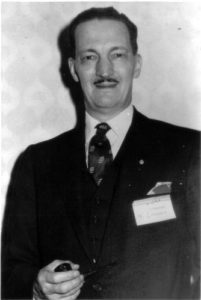So as I was writing yesterday’s post on Raymond Z. Gallun and his story “Old Faithful”, I couldn’t help but think of H. Beam Piper’s “Omnilingual”. Both stories concern communication between Earth and Mars. Gallun dealt with two living species trying to find common ground for communication. Piper ups the ante by having a group of archaeologists, or rather one archaeologist in particular, try to find common ground and read the writings left behind by a long dead race.
After posting that review, I checked the ISFDB to see if there were any birthdays of note today. Lo and behold, whose name did I see but H. Beam Piper’s? Talk about good timing. (The universe made up for it this today.)
Henry Beam Piper was born on March 23, 1904. He has been forgotten by many readers, especially younger readers, and that’s a shame. He was one of the best writers the field produced in the middle of the last century. If he had lived longer (he died in 1964), perhaps he would be better known today.
Piper published most of his stories in Astounding, so this post also counts at a 90th Anniversary post for Astounding. “Omnilingual” first appeared in the February 1957 issue.
This review is going to contain spoilers. If you want to read the story first, it’s currently available in The Rise of the Terran Federation, edited by John F. Carr or in the H.Beam Piper Megapack, which contains some of his nonfiction.
The majority of Piper’s work falls into an extensive future history called the Terran Federation, of which “Omnilingual” is a part. The best known novel is Little Fuzzy, and I’m not talking about the rewrite Scalzi did a few years ago. The less said about that, the better. There are similarities to Poul Anderson’s Technic Future History in that they both draw heavily from history. Piper is just a bit more upfront about it. Not that that’s a bad thing. It was reading Piper in high school and early college that help re awaken my love of history.
 “Omnilingual” takes place early in the Federation’s history, when humans are just beginning to explore the solar system. The protagonist is a woman named Martha Dane, who is trying to decipher the ancient Martian language. The Martians were highly advanced, but their civilization collapsed thousands of years ago. All that’s left are ruins.
“Omnilingual” takes place early in the Federation’s history, when humans are just beginning to explore the solar system. The protagonist is a woman named Martha Dane, who is trying to decipher the ancient Martian language. The Martians were highly advanced, but their civilization collapsed thousands of years ago. All that’s left are ruins.
Yes, you read that right W. Campbell, Jr., published a story in 1957 in which a woman scientist was the lead character, and she was presented sympathetically. This wasn’t as big a deal as some people make it out to be. We’ve talked about that before. There are also supporting women characters.
There are some minor details that are a bit dated. Most of the characters smoke and don’t hesitate to light up in a crowded room. Some the language, such as referring to some of the women as “girls” could be a bit jarring to a modern reader.
The story is a bit long, but Piper takes his time developing the situation and showing how the different characters grow and change through the excavation. It’s easy to see how this story is considered one of Piper’s best, if not the best.
Spoiler: I don’t think it will be a big surprise to too many people that the way they figure out the Martian writing is by finding a periodic table. That idea has been used a lot since then.
Piper was one of the better writers from the 50s and early 60s. It’s a shame he isn’t better known today. Do yourself a favor and check his work out.


Hear hear! We lost Piper last year, a great loss to the genre.
I believe you’re thinking of Jerry Pournelle. He was champion of Piper’s works. Piper died in the 60s.
Pingback: Links: 2019-03-23 | Featured Futures